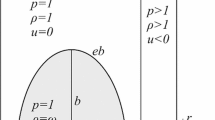Abstract
The trajectory of the primary shock produced by the explosion of a nominal 18.14 t (20 tn) hemispherical propane/oxygen charge was analysed previously to provide the physical properties immediately behind the shock, but gave no information about the time-resolved properties throughout the blast wave. The present study maps all the physical properties of the wave throughout and beyond the positive durations for a range of distances from about 1.6–18 m scaled to a 1 kg charge at NTP. The physical properties were calculated using a hydro-code to simulate the flow field produced by a spherical piston moving with a specific trajectory. This technique has been used extensively to determine the physical properties of blast waves from a variety of sources for which the piston path was determined by high-speed photography of smoke tracers established close to the charges immediately before detonation. In the case of the propane/oxygen explosion, smoke tracer data were not available to determine the trajectory of the spherical piston. An arbitrary piston path was used and its trajectory iteratively adjusted until it produced a blast wave with a primary shock whose trajectory exactly matched the measured trajectory from the propane/oxygen explosion. Throughout the studied flow field the time histories of hydrostatic pressure, density and particle velocity are well described by fits to the modified Friedlander equation. The properties are presented as functions of scaled radius and are compared with the properties of the blast wave from a 1 kg TNT surface burst explosion, and with other measurements of the same explosion.










Similar content being viewed by others
Notes
BLEVE stands for Boiling Liquid Expanding Vapour Explosion. When a railway freight car or truck containing liquid fuel is involved in an accident, leaking fuel may ignite, enveloping the container in flame. This may cause the liquid fuel to boil, and the resulting expanding vapour may create sufficient pressure to explosively rupture the container. This ejects the fuel in a vapour and aerosol cloud which mixes with air, and if ignited, will produce a very energetic explosion that can cause injury and damage over a large area.
References
Dewey, J.M.: The TNT equivalence of an optimum propane-oxygen mixture. J. Phys. D Appl. Phys. 38, 4245–4251 (2005)
Reisler, R.E., Ethridge, N.H., LeFevre, D.P., Giglio-Tos, L.: Air blast measurements from the detonation of an explosive gas contained in a hemispherical balloon (Operation Distant Plain, Event 2a). Ballistic Res. Lab. Mem. Rep, No. 2104 (1971)
Moen, I.O., Funk, J.W., Thibault, P.A.: Blast waves from non-spherical fuel-air explosions. Proc. 8th Int. Symp. Mil. Aspects of Blast. Simulation I(7), 1–24 (1983)
Brossard, J., Leyer, J.C., Desbordes, D., Saint-Cloud, J.P., Hendricks, S., Garnier, J.L., Lannoy, A., Perrot, J.: Air blast from unconfined gaseous detonations. In: Bowen, J.R., Mason, N., Oppenheim, R.I., Soloukhin, R.I. (eds.) Dynamics of shock waves, explosions, and detonations, Prog. Astronautics and Aeronautics, 94, 556–566 (1985)
Anderson, J.H.B: Canadian air blast measurements from Operation ‘DISTANT PLAIN’ Event 2A, Suffield Tech. Note No. 270, Defence Research Establishment, Suffield, Ralston, AB, Canada (1970)
Taylor, G.I.: The air waves surrounding an expanding sphere. Proc. Roy. Soc. Lond. A 186, 273–292 (1946)
Dewey, J.M.: The air velocity in blast waves from t.n.t. explosions. Proc. Roy. Soc. A 279, 366–385 (1964)
Dewey, J.M.: The properties of a blast wave obtained from an analysis of the particle trajectories. Proc. Roy. Soc. Lond. A 324, 275–299 (1971)
Dewey, J.M., McMillin, D.J.: Smoke puff photo-diagnostics, MISERS GOLD Symp. Rep, Def. Nucl. Agency, Alexandria, VA, USA, 22310–3398. POR 7352–2, Vol. II (1991)
Dewey, J.M., McMillin, D.J.: Smoke trail photo-diagnostics. MINOR UNCLE Symp. Rep., Event Diagnostics and Calculations, Vol. 2, 1–48, Def. Nucl. Agency, Alexandria, VA, USA, 22310–3398, POR 7453–2 (1995)
Saito, T., Glass, I.I.: Application of random-choice method to problems in shock and detonation-wave dynamics, UTIAS Rep. No. 240, Univ. Toronto, Ontario, Canada (1984)
Dewey, J.M.: Expanding spherical shocks (blast waves), Chapt. 13.1, Spherical shock waves. In: Ben-Dor, G., Igra, O., Elperin, T. (eds.) Handbook of Shock Waves, vol. 2, Academic Press, San Diego, USA (2001)
Dewey, J.M.: The Rankine-Hugoniot equations: their extensions and inversions related to blast waves. Proc. 19th Int. Symp. Mil. Aspects Blast and Shock, Defence R & D, Suffield, Canada (2006)
Dewey, J.M.: The shape of the blast wave: studies of the Friedlander equation. Proc. 21 Int. Symp. Mil. Aspects of Blast and Shock. Jerusalem, Israel (2010)
Friedlander, F.G.: The diffraction of sound pulses. I. Diffraction by a semi-infinite plate. Proc. Roy. Soc. Lond. A 186, 332–344 (1946)
Baker, W.E., Cox, P.A., Westine, P.S., Kulesz, J.J., Strehlow, R.A.: Explosive Hazards and Evaluation. Elsevier, New York, NY (1983)
Acknowledgments
The authors gratefully acknowledge the assistance of A. A. Van Netten and D. J. McMillin in the use of the piston-path random-choice method. The curve fitting, analysis and plotting was done using SigmaPlot 12 (Systat Software Inc.).
Author information
Authors and Affiliations
Corresponding author
Additional information
Communicated by F. Zhang.
Rights and permissions
About this article
Cite this article
Dewey, M.C., Dewey, J.M. The physical properties of the blast wave produced by a stoichiometric propane/oxygen explosion. Shock Waves 24, 593–601 (2014). https://doi.org/10.1007/s00193-014-0521-8
Received:
Revised:
Accepted:
Published:
Issue Date:
DOI: https://doi.org/10.1007/s00193-014-0521-8




